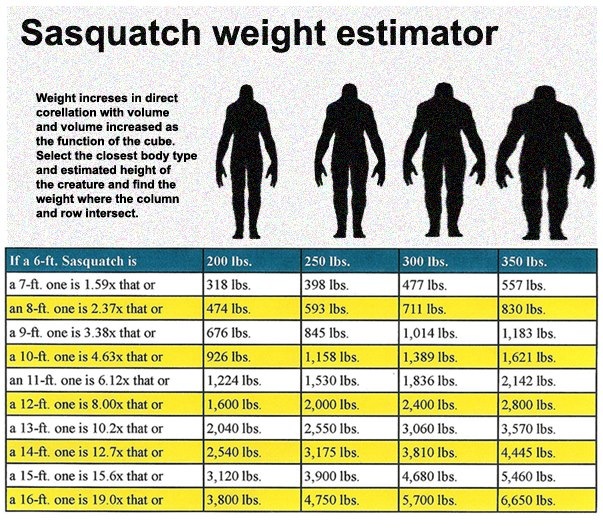Just How Big Was That Bigfoot?
Posted by: Craig Woolheater on March 16th, 2013
John Green’s 1968 recreation of the PGF on-site at Bluff Creek, featuring Jim McClarin walking in more or less the same track-way as the Bigfoot Patterson-Gimlin film subject.
Jim McClarin posted the following chart on his facebook page, along with the commentary.

Worked on this when I should have been doing other things. I hope it helps people trying to guess the weight of the Sasquatch they saw.
Someone had opined that the farther north you go, the bigger the Sasquatches are reported to be, all the way up to 16 feet. I can’t vouch for this but was nevertheless curious what a 16-ft creature would weigh, and that was the genesis of my table. 🙂
…how I arrived at the coefficients in my table so I add my answer here:
Since we only have height as a dimension in my table I used it to form my cube value. Of course you will never see a squatch 7’x7’x7′ but all we are after is a consistent value to compare in order to arrive at a coefficient for weight/volume. So I cubed each height on the table, then divided the value for a six-footer into the value for each of the other heights to arrive at my coefficient.
The result would be the same if we took a standard fraction of the cubed value that might more closely approximate the actual volume of the creature but it’s an unnecessary step to arrive at a coefficient. (By coincidence, because of the wieght of a cubic foot of flesh, the height-cubed value is about the number of pounds a very skinny Sasquatch would weigh.)
My math:
6 cubed = 216 = 1.00×216
7 cubed = 343 = 1.59×216
8 cubed = 512 = 2.37×216
9 cubed = 729 = 3.38×216
10 cubed = 1,000 = 4.63×216
11 cubed = 1,331 = 6.16×216
12 cubed = 1,728 = 8.00×216
13 cubed = 2,197 = 10.2×216
14 cubed = 2,744 = 12.7×216
15 cubed = 3,375 = 15.6×216
16 cubed = 4,096 = 19.0×216
About Craig Woolheater
Co-founder of Cryptomundo in 2005.
I have appeared in or contributed to the following TV programs, documentaries and films:
OLN's Mysterious Encounters: "Caddo Critter", Southern Fried Bigfoot, Travel Channel's Weird Travels: "Bigfoot", History Channel's MonsterQuest: "Swamp Stalker", The Wild Man of the Navidad, Destination America's Monsters and Mysteries in America: Texas Terror - Lake Worth Monster, Animal Planet's Finding Bigfoot: Return to Boggy Creek and Beast of the Bayou.









Wow, impressive graph. Incredibly helpful to figure out size!
Very interesting chart that.
One to copy and paste, most definitely.
That’ll be useful the next time someone sees a 14-foot, ton-and-half Bigfoot. SERIOUSLY?
Huh?
A formula I use is W2=W1*(D2/D1)^3, where D=dimension, whether it is length, height, width. If you are doubling that dimension and all other maintain the same proportions, then the weight scales by the ratio of the new dimension over the old dimension cubed.
So for scaling by height, W2=W1*(H2/H1)^3
The figures match up with Jim’s, i.e. using the lighter body type, 6ft=200lbs, scaled to 10ft would be 925.9lbs, or 926lbs.
It is not an entirely accurate method for scaling organisms weights, as larger sizes may require the skeletal structure to become more robust, but it is probably the best approximation.
Insanity:
Wow, that’s a lot of math stuff to begin with. Can I guess that you either hobby or professionally study animals? The figures are pretty interesting, without much more than a glimpse you can figure out something’s weight and height and no doubt much more. It’s almost creepy!
It is more geometry then biology, as the same formula works for any object. Double the side lengths of a cube, and it will weigh 8x the original. Double the radios of a sphere, it weighs 8x the original. As I said it is probably not entirely accurate for organisms, but a good approximation.